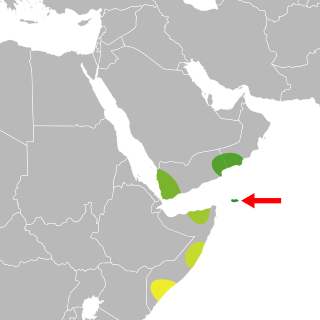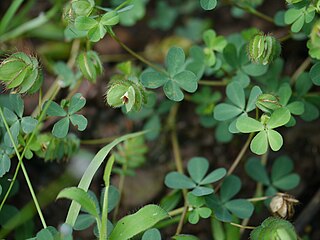Weberbauerella is a South American genus of flowering plants in the family Fabaceae. It was recently assigned to the informal monophyletic Dalbergia clade of the Dalbergieae.

Centrolobium is a Neotropical genus of flowering plants in the family Fabaceae, assigned to the informal monophyletic Pterocarpus clade of the Dalbergieae. The genus comprises mostly large trees to 30 m tall, characterised by an abundance of orange peltate glands that cover most parts of the plant, and fruits that are large winged samaras to 30 cm long with a spiny basal seed chamber.
Ormocarpopsis is a genus of flowering plants in the family Fabaceae, and was recently assigned to the informal monophyletic Dalbergia clade of the Dalbergieae. It contains the following species:
Paramachaerium is a genus of flowering plants in the family Fabaceae native to Amazonia. It was recently assigned to the informal monophyletic Pterocarpus clade within the Dalbergieae.

Zygocarpum is a genus of flowering plants in the family Fabaceae, and was recently assigned to the informal monophyletic Dalbergia clade of the Dalbergieae. A dichotomous key of the species of Zygocarpum has been published.

Brya is a genus of flowering plants in the legume family, Fabaceae. It includes seven species of shrubs or small spreading trees native to Cuba and Hispaniola in the Caribbean. It belongs to the subfamily Faboideae, and was recently assigned to the informal monophyletic Pterocarpus clade of the Dalbergieae. Species include Brya ebenus, a valuable timber tree.
Bryaspis is a small genus of flowering plants in the legume family, Fabaceae. It includes two species of herbaceous plants native to equatorial West Africa and Cameroon. It belongs to the subfamily Faboideae, and was recently assigned to the informal monophyletic Dalbergia clade of the Dalbergieae. Typical habitats are seasonally dry tropical grassland and open areas, often growing in wet, swampy, rocky and sandy soil. Plants can be weeds on cultivated land.
Cascaronia astragalina is a species of flowering plant in the legume family, Fabaceae. It is the only member of the genus Cascaronia. It is a spindly shrub or multi-stemmed tree native to southern Bolivia and northwestern Argentina. It grows in seasonally-dry subtropical forests, at forest margins and along rivers.

Cranocarpus is a genus of flowering plants in the legume family, Fabaceae. It includes three species native to northern and eastern Brazil. It belongs to subfamily Faboideae, and was recently assigned to the informal monophyletic Pterocarpus clade of the Dalbergieae.
Discolobium is a genus of flowering plants in the legume family, Fabaceae. It belongs to the subfamily Faboideae, and was recently assigned to the informal monophyletic Pterocarpus clade of the Dalbergieae. It includes seven species native to South America, ranging from northern Brazil to Bolivia and northern Argentina.
Fissicalyx fendleri is a species of flowering plant in the legume family, Fabaceae. It is a tree native to the tropical Americas, ranging from Panama through Colombia, Venezuela, and Guyana to northern Brazil. It grows in humid lowland forest.

Geissaspis is a genus of flowering plants in the legume family, Fabaceae. It contains one accepted species, Geissaspis cristata. It is a scrambling annual or perennial which ranges from the Indian Subcontinent through Indochina to southern China and Peninsular Malaysia. It has three varieties:
Grazielodendron riodocensis is a species of flowering plant in the legume family, Fabaceae. It belongs to the subfamily Faboideae, and was recently assigned to the informal monophyletic Pterocarpus clade within the Dalbergieae. It is the only member of the genus Grazielodendron. It is only found in eastern Brazil.

Inocarpus is a small genus of flowering plants belonging to the subfamily Faboideae of the legume family, Fabaceae, and was recently assigned to the informal monophyletic Pterocarpus clade within the Dalbergieae.
Ramorinoa girolae is a species of flowering plant in the legume family, Fabaceae. It belongs to the subfamily Faboideae, and was recently assigned to the informal monophyletic Pterocarpus clade within the Dalbergieae. It is the only member of the genus Ramorinoa. Unlike most legumes, Ramorinoa girolae does not produce any leaves.
Riedeliella is a genus of flowering plants in the legume family, Fabaceae. It belongs to the subfamily Faboideae, and was recently assigned to the informal monophyletic Pterocarpus clade within the Dalbergieae.
Soemmeringia semperflorens is a species of flowering plants in the legume family, Fabaceae. It belongs to the subfamily Faboideae, and was recently assigned to the informal monophyletic Dalbergia clade of the Dalbergieae. It is the only member of the genus Soemmeringia.
Steinbachiella leptoclada is recently reinstated species of legume in the family Fabaceae, assigned to the informal monophyletic Dalbergia clade of the Dalbergieae. It is the only member of the monotypic genus Steinbachiella.
Maraniona lavinii is a species of legume in the family Fabaceae, and was recently assigned to the informal monophyletic Pterocarpus clade of the Dalbergieae. It is endemic to the Marañón Valley in northern Peru. It is the only member of the genus Maraniona and is closely related to the genus Tipuana.

The dalbergioids are an early-branching monophyletic clade of the flowering plant subfamily Faboideae or Papilionaceae. They are pantropical, particularly being found in the neotropics and sub-Saharan Africa. This clade is consistently resolved as monophyletic in molecular phylogenetic analyses. It is estimated to have arisen 55.3 ± 0.5 million years ago. A node-based definition for the dalbergioids is: "The least inclusive crown clade that contains Amorpha fruticosaL. 1753 and Dalbergia sissooRoxb. ex DC. 1825." Indehiscent pods may be a morphological synapomorphy for the clade.








